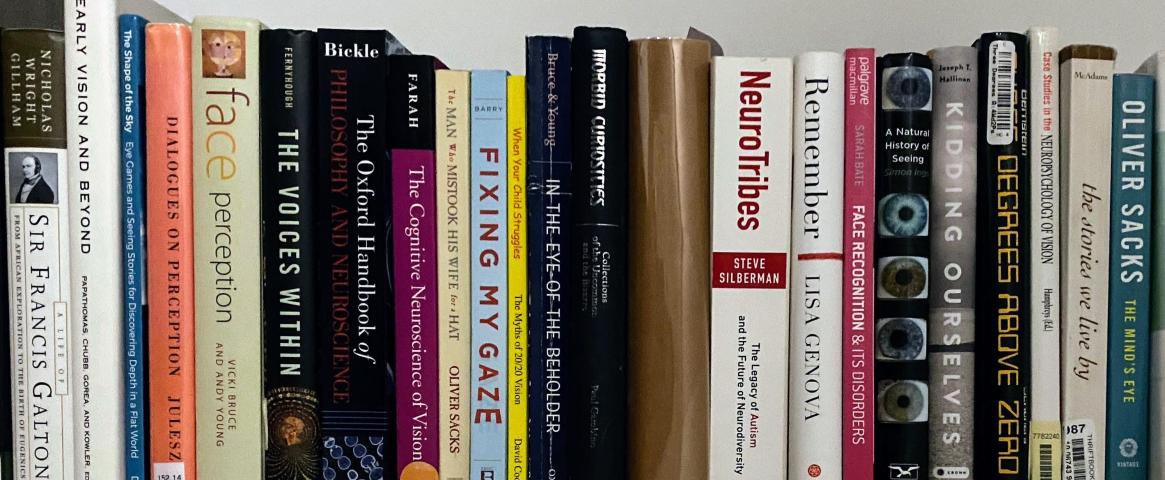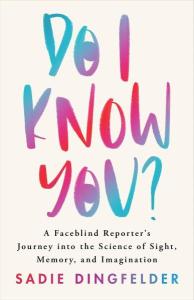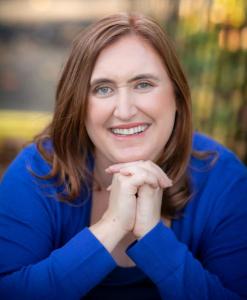
Sadie Dingfelder—Do I Know You? A Faceblind Reporter’s Journey into the Science of Sight, Memory, and Imagination
A FACEBLIND REPORTER'S JOURNEY INTO THE
SCIENCE OF SIGHT, MEMORY AND IMAGINATION
Sadie Dingfelder
Little, Brown & Co., Spark, June 25, 2024
Hardcover, $32, eBook, $15.99, audio book, $17.05
ISBN-10: 0316545147, ISBN-13: 978-0316545143
Audio book ASIN: B0CKNMC3MG
Dingfelder reports:
My book began as a funny "memoir in essays" in the style of David Sedaris. As I was working on these stories, I had a dawning awareness that I make a lot of weird mistakes. For instance, I once accosted a random man in a grocery store because I thought he was my husband.
Then I thought, "Wait, could I be faceblind?" This sent me down a rabbit hole where I discovered that I am, indeed, quite faceblind. But why? I found studies that supported my hunch that my prosopagnosia probably stems from the fact that my right hemisphere’s fusiform face area (FFA) did not get the early-life exposure to faces that it needed. One study I participated in at the Harvard lab of Joe DeGutis found that my FFA is too thick, which suggests that it did not get the neural pruning it needed.I also discovered that I have aphantasia, which means that I cannot visualize. I actually did not realize that other people could sort-of hallucinate on demand. I participated in an fMRI study at the University of Chicago lab of Wilma Bainbridge that confirmed my self-report.
Finally, I found out that I have Severely Deficient Autobiographical Memory, which hinders how I store memories. Turns out my left hippocampus is slightly larger than my right hippocampus. Neurotypical brains generally show the opposite asymmetry. That study was done at the lab of Brian Levine at the Rotman Research Institute in Toronto.
I’d emailed book agents with my David Sedaris memoir-in-essays proposal, and they were not impressed. But when I emailed them a proposal for a science-memoir mashup about a nerdy midlife crisis that was already in progress they were into it.
I am fortunate, as a science writer, to be in possession of a brain weird enough to interest seven teams of researchers. I ended up spending more than 30 hours in MRI machines, including a 7-Tesla one that made me dizzy.
This book isn’t just about me, however. It’s about the new science of subjectivity and that scientists are taking inner experiences seriously for the first time in more than a century.
Contact info:
- Sadie Dingfelder, Sadie@sadied.com; https://www.sadied.com/
Facebook: @SadieFDingfelder
X (Twitter): @sadieding
Instagram: @sadiefd
Tiktok: @sadiedingfelder - Book: Do I Know You? A Faceblind Reporter's Journey into the Science of Sight, Memory and Imagination
- Publicist: Juliana Horbachevsky, 212-364-1464, Juliana.Horbachevsky@hbgusa.com
- Agent: Dara Kaye, 202-600-4570, Dkaye@wmeagency.com
NASW members: will your book be published soon? Promote it by submitting your report for Advance Copy.
Tell your fellow NASW members how you came up with the idea for your book, developed a proposal, found an agent and publisher, funded and conducted research, and put the book together. Include what you wish you had known before you began working on your book, or had done differently.
See https://www.nasw.org/advance-copy-submission-guidelines.
View Advance Copy archives at https://www.nasw.org/member-article/advance-copy.
Thinking of writing a book? If you are a NASW member, you may access a list of more than 200 books and online resources to help you craft your book proposal, find an agent and funding sources, negotiate your contract, learn about self-publishing, publicize and market your book, and more at https://www.nasw.org/article/write-book.
View the recording of an Advance Copy Virtual Business Chat, A Primer for Authors on Book Publicity. NASW member login required.
View the recording of a Virtual Business Chat presented by NASW’s Freelance Committee and Advance Copy column Writing Wikipedia Profiles. NASW member login required.
View the recording of a recent Virtual Skills Chat presented by NASW’s Freelance Committee Using Generative A.I. as Writers and Editors. NASW member login required.
Send book info and questions about book publishing to Lynne Lamberg, NASW book editor, llamberg@nasw.org.
Follow @LynneLamberg and @lynnelamberg.bsky.social for news about NASW authors, science/medical books, and writing.
Banner image adapted from original photo by Sadie Dingfelder.
NASW invites publishers and publicists to purchase NASW website ads to promote their authors and books via NASW’s self-service purchasing portal.
Advance Copy
The path from idea to book may take myriad routes. The Advance Copy column, started in 2000 by NASW volunteer book editor Lynne Lamberg, features NASW authors telling the stories behind their books. Authors are asked to report how they got their idea, honed it into a proposal, found an agent and a publisher, funded and conducted their research, and organized their writing process. They also are asked to share what they wish they’d known when they started or would do differently next time, and what advice they can offer aspiring authors. Lamberg edits the authors’ answers to produce the Advance Copy reports.
NASW members: Will your book be published soon? Visit www.nasw.org/advance-copy-submission-guidelines for information on submitting your report.
Publication of NASW author reports in Advance Copy does not constitute NASW's endorsement of any publication or the ideas, values, or material contained within or espoused by authors or their books. We hope this column stimulates productive discussions on important topics now and in the future as both science and societies progress. We welcome your discussion in the comments section below.





